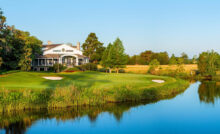How to Be a Bee-Friendly Golf Course


bees on golf courses
Native pollinators require food in the form of flowering plants that produce nectar and pollen. Plant with purpose and don’t overlook the diversity of wildflowers native to your area.
• From wildflowers to flowering shrubs to hanging baskets, seek diversity in the range of plants you maintain. Both native and hived bees benefit from variety in their diets. Consider the color of plants, striving for a broad range, for not all pollinators see colors in the same ways.
• To the degree possible, try to have nectar and pollen-producing plants across the full capacity of your blooming season. Incorporate both annuals and perennials.
Related: The Buzz about Bees on Golf Courses
• Native pollinators require habitat. Hedgerows, buffer strips, and natural brush provides habitat areas. Save the time and cost of mowing and irrigation by naturalizing more acreage, and where you must mow areas of rough or long grass, reduce the frequency.
• Use as little pesticide as possible.
• When creating native vegetation areas remember that if they are narrow, golfers are more likely to enter them in search of a lost ball. Making the habitat less inviting to humans makes it more inviting to pollinators.
Related: A Bee Friendly Golf Industry Means More than Beekeeping
• Pollinators need fresh water.
• Learn about the nesting patterns of native bees, which often involve bare ground, logs, stumps, and other natural items you might previously have called, “debris.”
• Read “Making Room for Native Pollinators: How to Create Habitat for Pollinator Insects on Golf Courses,” (available Xerces.org ) published by the USGA and the Xerces Society.
Related: All-In-One Beekeeping for the Bees for Your Course
Lastly, if you add beehives to your golf course, remember to increase your plantings to provide food sources to your hived bees while assuring that your hived bees won’t be competing with the food supply of existing native bees and pollinators.
Linda Parker has been writing professionally since the 1980s. With clients in finance, sports, technology, resorts, and nonprofit global initiatives, Linda helps organizations communicate their stories in meaningful ways to the people they most want to reach. She has authored, ghostwritten, or contributed to more than a dozen nonfiction books. Linda is a member of the Authors Guild and the Golf Writers Association of America. You can connect with her at linda@glindacreative.com
Recent Posts
One of the Biggest Jobs in Golf
When Rory McIlroy finally slipped into the Green Jacket on Sunday, April 13, 2025, after…
Audubon International Marks Earth Day In Growth Mode
As the world celebrates Earth Day on April 22, Audubon International – the environmentally focused non-profit…
Help keep golf sustainable by bidding in GCSAA’s Rounds 4 Research online auction
In celebration of Earth Day, you can help fund the research that advances golf’s environmental…
Five Cabot Golf Courses Place in Golfweek’s Prestigious 2025 Top 100 International Courses List
Cabot, a developer and operator of luxury resort and residential golf destinations, is proud to…
Champion Hills Rebuilds with Heart: A Story of Resilience and Restoration
When Hurricane Helene swept through in late September 2024, Champion Hills Golf Club faced a…
Discover the New Graves Golf Club: A Game-Changing Facility in Edmond, OK
Graves Golf Club, the much-anticipated golf and training destination founded by celebrated instructors Tim and…


